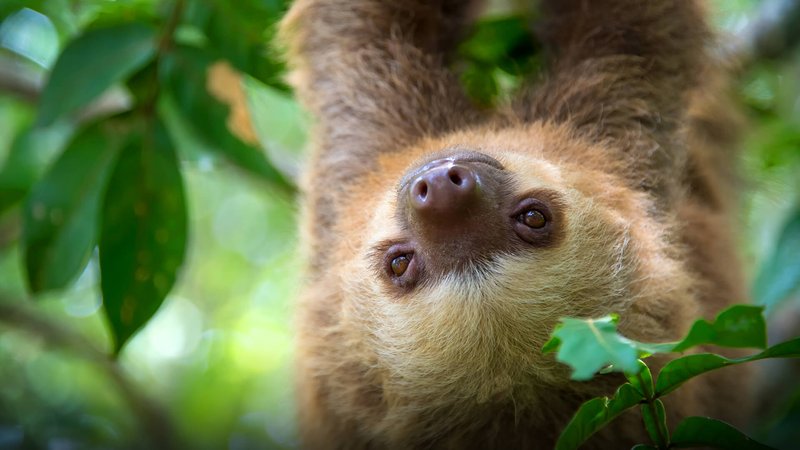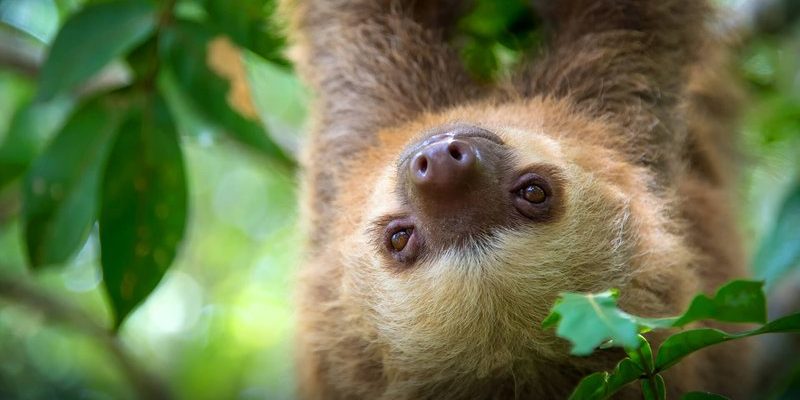
Meet The Two-Toed Sloth
Now, you might be wondering what makes the two-toed sloth so special. Unlike its three-toed cousin, the two-toed sloth has, well, two toes on its front limbs. They mainly live in the forests of Central and South America and are known for their slow movement—perfectly designed for a life spent hanging out in trees. With their long limbs and specialized muscles, they can effortlessly hang upside down.
These sloths feed mainly on leaves, fruits, and flowers, which makes them a crucial part of the forest’s food web. But it’s not just their diet that matters; it’s also how they interact with other species. Their relaxed lifestyle means they spend a lot of time in the canopy where many plants and animals thrive.
Diet and Feeding Habits
Let’s talk about what two-toed sloths eat. They primarily munch on the leaves of various trees, but they can be quite picky. They tend to favor certain types like cecropia leaves, which are low in protein but high in fiber. This diet is important for two reasons: it decreases the sloth’s metabolic rate and helps them conserve energy.
The slow digestion process means these sloths can go for days without eating. Imagine you’re at a buffet, and while everyone else is piling on the plate, you’re just nibbling a salad leaf. But there’s a twist! Since sloths eat leaves that are hard to digest, the nutrients they absorb can also benefit the plants they consume. When sloths poop, they provide natural fertilizer, enriching the soil.
Habitat and the Importance of Trees
Two-toed sloths live almost exclusively in trees; they’re true tree-huggers! Their fur helps them blend in with the leaves, offering camouflage from predators like jaguars and harpy eagles. Living in these arboreal havens, sloths also contribute to the ecosystem by aiding in tree pollination and seed dispersal.
As sloths move from tree to tree—although it might take them a while!—they unintentionally act as pollinators. Flowers blooming in their vicinity can benefit from the sloth’s slow travel, promoting greater biodiversity in the forest. You could think of the sloth as the forest’s slow-moving gardener, helping to foster new growth.
The Sloth-Algae Connection
Here’s where things get creative: *sloths and algae.* Yes, you read that right! The fur of two-toed sloths often hosts algae, which not only camouflages them but also provides additional nutrients when ingested. It’s a unique relationship that further illustrates the interconnectedness of species in an ecosystem.
The algae can also attract insects that serve as a food source for sloths. This multi-layered connection highlights how a seemingly simple creature like the two-toed sloth can be a fundamental player in a much larger game. So, while sloths are lounging in the trees, they are, in reality, a part of a precise ecological dance.
Conservation and Threats
Like many species, two-toed sloths are facing threats, primarily from habitat destruction and climate change. Logging in tropical forests and development projects reduce their natural habitats, making it increasingly difficult for them to find food and shelter. Here’s the thing: every time a tree is cut down, it impacts not just the sloth but countless other species relying on the same ecosystem.
Conservation efforts are essential to ensure the survival of these fascinating creatures. Protecting their habitats through responsible forestry practices and creating wildlife reserves can make a significant difference. Advocacy and awareness campaigns can help raise consciousness about the importance of sloths in their ecosystems.
Sloths and Ecosystem Health
So, why do sloths matter? Simply put, they are a pivotal piece of the ecological puzzle. Their eating habits, habitat interactions, and even their relationships with through algae show that they contribute to a healthier ecosystem.
When you think about it, nature thrives on balance. The decline of any species can lead to larger consequences. Protecting the two-toed sloth helps maintain the integrity of the forest ecosystems they inhabit.
In conclusion, while the two-toed sloth may seem like a simple creature with a laid-back lifestyle, its role in the ecosystem is far from trivial. From fertilizing the soil to aiding in pollination and showcasing the beauty of nature, these sloths are vital in keeping the forest alive and thriving.
By learning about and supporting conservation efforts, we can help preserve not only the two-toed sloth but also the intricate ecosystems they inhabit. So, next time you think about these charming creatures, remember that they’re more than just adorable faces—they’re essential for a balanced environment. Let’s work together to ensure their home remains a vibrant, flourishing place for generations to come.

